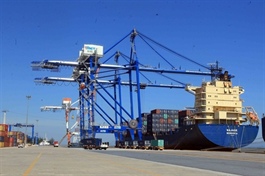Plenty of room for Vietnamese exports to Africa
Plenty of room for Vietnamese exports to Africa
There is plenty of room for Vietnamese products to gain a bigger market share in Africa, as the country accounts for only 0.6 per cent of the continent's total imports of US$600 billion per year, according to the Ministry of Industry and Trade (MoIT).

Workers of BaZan coffee company in Dak Nong Province pack instant coffee. Coffee is among the key commodities that Viet Nam can promote exports to Africa. — VNA/VNS Photo Vu Sinh |
Vietnamese exports to Africa can also enjoy new opportunities brought about by the African Continental Free Trade Area (AfCFTA) agreement, the MoIT said.
To facilitate intra-bloc trade, African nations will pour more capital into infrastructure facilities, thus offering opportunities for Vietnamese goods to access more markets, including 15 landlocked countries, in Africa.
Currently, Viet Nam’s main export markets in the region are major economies with seaports such as South Africa, Egypt and Nigeria.
Countries around the world are planning to study, negotiate and sign international trade agreements, especially free trade agreements (FTAs), with the African Continental Free Trade Area. This will help them save time negotiating with individual countries or regions (Africa currently has 55 countries divided into eight economic regions).
African countries have quite similar production structures, mainly primary products such as crude oil, raw agricultural products, minerals, and precious metals, according to the ministry.
Even if the AfCFTA agreement takes effect across the region, the continent still cannot guarantee the supply of machinery, equipment, rice, textiles, footwear, and processed aquatic products; and still has to depend on imports from foreign countries.
Therefore, there remains huge potential for Viet Nam to export its key commodities such as rice, coffee, garment and textiles, footwear, and aquatic products to Africa.
According to the ministry, Viet Nam could increase its exports of textile, leather and footwear products to Africa by promoting competitive advantages such as low labour costs, good sewing techniques, and high-quality products, if the nation or the Association of Southeast Asian Nations (ASEAN) negotiated a trade agreement with the AfCFTA.
Statistics from the ministry's Asian-African Market Department revealed that trade between Viet Nam and Africa increased to $5.5 billion in 2022 from $2.52 billion in 2010.
During the year, Viet Nam exported over $2.8 billion worth of goods from the bloc, resulting in a trade surplus of $226.3 million. Among Viet Nam's major items were rice with a turnover of $568.6 million; phones and parts ($355.6 million); computers and electronics ($210.4 million); and footwear ($141.8 million).
At the same time, it spent $1.1 billion in importing cashew nuts from this continent besides metals ($484.1 million); wood and wood products ($114.3 million).
The AfCFTA is the world’s largest free trade area bringing together the 55 countries of the African Union (AU) and eight Regional Economic Communities (RECs).
The overall mandate of the AfCFTA is to create a single continental market with a population of about 1.3 billion people and a combined GDP of approximately $3.4 trillion.
As part of its mandate, the AfCFTA is to eliminate trade barriers and boost intra-Africa trade. In particular, it is to advance trade in value-added production across all service sectors of the African Economy.
The AfCFTA will contribute to establishing regional value chains in Africa, enabling investment and job creation. The practical implementation of the AfCFTA has the potential to foster industrialisation, job creation, and investment, thus enhancing the competitiveness of Africa in the medium to long term.
As of March 2023, 54 AU member states had signed the AfCFTA agreement, according to the AfCFTA official website au-afcfta.org.


























